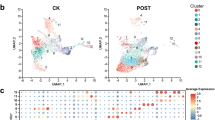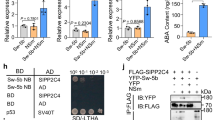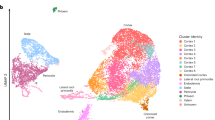Abstract
Understanding the gene regulation of plant pathogens is crucial for pest control and thus global food security. An integrated understanding of bacterial gene regulation in the host is dependent on multi-omic datasets, but these are largely lacking. Here, we simultaneously characterized the transcriptome and proteome of a bacterial pathogen in plants. We found a number of bacterial processes affected by plant immunity at the transcriptome and proteome levels. For instance, salicylic acid-mediated plant immunity suppressed the accumulation of proteins comprising the tip component of the bacterial type III secretion system. Interestingly, there were instances of concordant and discordant regulation of bacterial messenger RNAs and proteins. Gene co-expression analysis uncovered previously unknown gene regulatory modules underlying virulence. This study provides molecular insights into the multiple layers of gene regulation that contribute to bacterial growth in planta, and elucidates the role of plant immunity in affecting pathogen responses.
This is a preview of subscription content, access via your institution
Access options
Access Nature and 54 other Nature Portfolio journals
Get Nature+, our best-value online-access subscription
$29.99 / 30 days
cancel any time
Subscribe to this journal
Receive 12 digital issues and online access to articles
$119.00 per year
only $9.92 per issue
Buy this article
- Purchase on Springer Link
- Instant access to full article PDF
Prices may be subject to local taxes which are calculated during checkout








Similar content being viewed by others
Data availability
Source Data for Fig. 6b are provided with the paper. The RNA-seq data used in this study are deposited in the National Center for Biotechnology Information Gene Expression Omnibus database (accession no. GSE138901). The mass spectrometry proteomics data are available at the ProteomeXchange Consortium via the PRIDE partner repository with the dataset identifier PXD015839.
Change history
21 July 2020
A Correction to this paper has been published: https://doi.org/10.1038/s41477-020-0746-8
References
Nobori, T., Mine, A. & Tsuda, K. Molecular networks in plant–pathogen holobiont. FEBS Lett. 592, 1937–1953 (2018).
Nobori, T. & Tsuda, K. The plant immune system in heterogeneous environments. Curr. Opin. Plant Biol. 50, 58–66 (2019).
Nobori, T. et al. Transcriptome landscape of a bacterial pathogen under plant immunity. Proc. Natl Acad. Sci. USA 115, E3055–E3064 (2018).
Kunkel, B. N., Bent, A. F., Dahlbeck, D., Innes, R. W. & Staskawicz, B. J. RPS2, an Arabidopsis disease resistance locus specifying recognition of Pseudomonas syringae strains expressing the avirulence gene avrRpt2. Plant Cell 5, 865–875 (1993).
Yu, G.-L., Katagiri, F. & Ausubel, F. M. Arabidopsis mutations at the RPS2 locus result in loss of resistance to Pseudomonas syringae strains expressing the avirulence gene avrRpt. Mol. Plant Microbe Interact. 6, 434–443 (1993).
Tsuda, K., Sato, M., Stoddard, T., Glazebrook, J. & Katagiri, F. Network properties of robust immunity in plants. PLOS Genet. 5, e1000772 (2009).
Zhang, W. et al. Plant–necrotroph co-transcriptome networks illuminate a metabolic battlefield. eLife 8, 1–32 (2019).
O’Connell, R. J. et al. Lifestyle transitions in plant pathogenic Colletotrichum fungi deciphered by genome and transcriptome analyses. Nat. Genet. 44, 1060–1065 (2012).
Abreu, R., de, S., Penalva, L. O., Marcotte, E. M. & Vogel, C. Global signatures of protein and mRNA expression levels. Mol. Biosyst. 5, 1512–1526 (2009).
Maier, T., Güell, M. & Serrano, L. Correlation of mRNA and protein in complex biological samples. FEBS Lett. 583, 3966–3973 (2009).
Müller, D. B., Schubert, O. T., Röst, H., Aebersold, R. & Vorholt, J. A. Systems-level proteomics of two ubiquitous leaf commensals reveals complementary adaptive traits for phyllosphere colonization. Mol. Cell. Proteomics 15, 3256–3269 (2016).
Levy, A., Conway, J. M., Dangl, J. L. & Woyke, T. Elucidating bacterial gene functions in the plant microbiome. Cell Host Microbe 24, 475–485 (2018).
Llamas, A., Imperi, F., Visca, P. & Lamont, I. L. Cell-surface signaling in Pseudomonas: stress responses, iron transport, and pathogenicity. FEMS Microbiol. Rev. 38, 569–597 (2014).
Lu, P., Vogel, C., Wang, R., Yao, X. & Marcotte, E. M. Absolute protein expression profiling estimates the relative contributions of transcriptional and translational regulation. Nat. Biotechnol. 25, 117–124 (2007).
Ishihama, Y. et al. Index (emPAI) for estimation of absolute protein amount in proteomics by the number of sequenced peptides per protein. Mol. Cell. Proteomics 4, 1265–1272 (2005).
Corbin, R. W. et al. Toward a protein profile of Escherichia coli: comparison to its transcription profile. Proc. Natl Acad. Sci. USA 100, 9232–9237 (2003).
Toruño, T. Y., Stergiopoulos, I. & Coaker, G. Plant-pathogen effectors: cellular probes interfering with plant defenses in spatial and temporal manners. Annu. Rev. Phytopathol. 54, 419–441 (2016).
Sreedharan, A., Penaloza-Vazquez, A., Kunkel, B. N. & Bender, C. L. CorR regulates multiple components of virulence in Pseudomonas syringae pv. tomato DC3000. Mol. Plant. Microbe. Interact. 19, 768–779 (2006).
Gygi, S. P., Rochon, Y., Franza, B. R. & Aebersold, R. Correlation between protein and mRNA abundance in yeast. Mol. Cell. Biol. 19, 1720–1730 (1999).
Ghazalpour, A. et al. Comparative analysis of proteome and transcriptome variation in mouse. PLoS Genet. 7, e1001393 (2011).
Foss, E. J. et al. Genetic basis of proteome variation in yeast. Nat. Genet. 39, 1369–1375 (2007).
Lan, P., Li, W. & Schmidt, W. Complementary proteome and transcriptome profiling in phosphate-deficient Arabidopsis roots reveals multiple levels of gene egulation. Mol. Cell. Proteomics 11, 1156–1166 (2012).
Marguerat, S. et al. Quantitative analysis of fission yeast transcriptomes and proteomes in proliferating and quiescent cells. Cell 151, 671–683 (2012).
Yao, J. & Allen, C. Chemotaxis is required for virulence and competitive fitness of the bacterial wilt pathogen Ralstonia solanacearum. J. Bacteriol. 188, 3697–3708 (2006).
Papenfort, K. & Bassler, B. L. Quorum sensing signal–response systems in Gram-negative bacteria. Nat. Rev. Microbiol. 14, 576–588 (2016).
Kvitko, B. H., Ramos, A. R., Morello, J. E., Oh, H. S. & Collmer, A. Identification of harpins in Pseudomonas syringae pv. tomato DC3000, which are functionally similar to HrpK1 in promoting translocation of type III secretion system effectors. J. Bacteriol. 189, 8059–8072 (2007).
Petnicki-Ocwieja, T., Van Dijk, K. & Alfano, J. R. The hrpK operon of Pseudomonas syringae pv. tomato DC3000 encodes two proteins secreted by the type III (Hrp) protein secretion system: HopB1 and HrpK, a putative type III translocator. Society 187, 649–663 (2005).
Wang, Y. et al. Site-specific cleavage of bacterial MucD by secreted proteases mediates antibacterial resistance in Arabidopsis. Nat. Commun. 10, 2853 (2019).
Mackey, D., Belkhadir, Y., Alonso, J. M., Ecker, J. R. & Dangl, J. L. Arabidopsis RIN4 is a target of the type III virulence effector AvrRpt2 and modulates RPS2-mediated resistance. Cell 112, 379–389 (2003).
Jirage, D. et al. Arabidopsis thaliana PAD4 encodes a lipase-like gene that is important for salicylic acid signaling. Proc. Natl Acad. Sci. USA 96, 13583–13588 (1999).
Wildermuth, M. C., Dewdney, J., Wu, G. & Ausubel, F. M. Isochorismate synthase is required to synthesize salicylic acid for plant defence. Nature 414, 562–565 (2001).
Tsuda, K. et al. Dual regulation of gene expression mediated by extended MAPK activation and salicylic acid contributes to robust innate immunity in Arabidopsis thaliana. PLoS Genet. 9, e1004015 (2013).
Kvitko, B. H. & Collmer, A. Construction of Pseudomonas syringae pv. tomato DC3000 mutant and polymutant strains. Methods Mol. Biol. 712, 109–128 (2011).
Huynh, T. V., Dahlbeck, D. & Staskawicz, B. J. Bacterial blight of soybean: regulation of a pathogen gene determining host cultivar specificity. Science 245, 1374–1377 (1989).
Tsuda, K., Sato, M., Glazebrook, J., Cohen, J. D. & Katagiri, F. Interplay between MAMP-triggered and SA-mediated defense responses. Plant J. 53, 763–775 (2008).
Nobori, T. & Tsuda, K. In planta transcriptome analysis of Pseudomonas syringae. Bio Protoc. 8, 1–8 (2018).
Langmead, B. & Salzberg, S. L. Fast gapped-read alignment with Bowtie 2. Nat. Methods 9, 357–360 (2012).
Anders, S., Pyl, P. T. & Huber, W. HTSeq A Python framework to work with high-throughput sequencing data. Bioinformatics 31, 166–169 (2014).
Storey, J. D. & Tibshirani, R. Statistical significance for genomewide studies. Proc. Natl Acad. Sci. USA 100, 9440–9445 (2003).
Hoon, M. J. L. De, Imoto, S., Nolan, J. & Miyano, S. Open source clustering software. Bioinformatics 20, 1453–1454 (2004).
Eisen, M. B., Spellman, P. T., Brown, P. O. & Botstein, D. Cluster analysis and display of genome-wide expression patterns. Proc. Natl Acad. Sci. USA 95, 12930–12933 (1998).
Maere, S., Heymans, K. & Kuiper, M. Systems biology BiNGO: a Cytoscape plugin to assess overrepresentation of Gene Ontology categories in Biological Networks. Bioinformatics 21, 3448–3449 (2005).
Bronstein, P. A. et al. Global transcriptional responses of Pseudomonas syringae DC3000 to changes in iron bioavailability in vitro. BMC Microbiol. 8, 209 (2008).
Borner, G. H. H. & Fielding, A. B. Using in-solution digestion, peptide fractionation, and a q exactive mass spectrometer to analyze the proteome of clathrin-coated vesicles. Cold Spring Harb. Protoc. 2014, 1192–1195 (2014).
Cox, J. & Mann, M. MaxQuant enables high peptide identification rates, individualized p.p.b.-range mass accuracies and proteome-wide protein quantification. Nat. Biotechnol. 26, 1367–1372 (2008).
Tyanova, S., Temu, T. & Cox, J. The MaxQuant computational platform for mass spectrometry-based shotgun proteomics. Nat. Protoc. 11, 2301–2319 (2016).
Robinson, M. D., McCarthy, D. J. & Smyth, G. K. edgeR: a Bioconductor package for differential expression analysis of digital gene expression data. Bioinformatics 26, 139–140 (2010).
Lin, Y., Hsu, S. & Huang, H. Evidence for the interaction between HrpT and HrcC of Pseudomonas syringae pv. syringae 61. Plant Pathol. Bull. 15, 171–185 (2006).
Alfano, J. R., Bauer, D. W., Milos, T. M. & Collmer, A. Analysis of the role of the Pseudomonas syringae pv. syringae HrpZ harpin in elicitation of the hypersensitive response in tobacco using functionally non-polar hrpZ deletion mutations, truncated HrpZ fragments, and hrmA mutations. Mol. Microbiol. 19, 715–728 (1996).
Acknowledgements
We thank S. Yang He for providing the HrpZ antibody, H.-C. Huang for providing the HrcC antibody and A. Harzen and K. Kramer for support in sample preparation and mass spectrometry analysis. We thank A. Collmer for the pCPP5040 plasmid, the Max Planck Genome Centre for sequencing support and N. Donnelly for critical comments on the manuscript. This work was supported by the Huazhong Agricultural University Scientific & Technological Self-innovation Foundation, the Max Planck Society, a German Research Foundation grant (no. SPP2125 to K.T.), a predoctoral fellowship from the Nakajima Foundation (to T.N.) and a postdoctoral fellowship from the Alexander von Humboldt Foundation (to Y.W.).
Author information
Authors and Affiliations
Contributions
T.N. and K.T. designed the research. T.N., Y.W., J.W., S.C.S., Y.T., I.F. and H.N. performed experiments. T.N. and K.T. wrote the paper with input from all authors.
Corresponding author
Ethics declarations
Competing interests
The authors declare no competing interests.
Additional information
Peer review information Nature Plants thanks Asaf Levy and the other, anonymous, reviewer(s) for their contribution to the peer review of this work.
Publisher’s note Springer Nature remains neutral with regard to jurisdictional claims in published maps and institutional affiliations.
Extended data
Extended Data Fig. 1 Overview of RNA-seq and proteome datasets.
Hierarchical clustering of relative expression (RE) of (a) RNA-seq data and (b) proteome data that were normalized separately. a, b, ps, pad4 sid2; rr, rpm1 rps2.
Extended Data Fig. 2 Normalization of RNA-seq and proteome data.
a, Heatmap of RNA-seq count data displaying 387 genes that are omitted from further analyses due to low average count (<5). Genes with average counts of zero were not displayed. b, Scatter plot comparing TMM-normalized iBAQ values and LFQ values of proteome data. The Pearson’s correlation coefficient was shown. (C) Q-Q plot of TMM-normalized iBAQ values. b, c, In vitro (KB) samples were used (n = 3).
Extended Data Fig. 3 Regulation of selected mRNAs and proteins.
a, b, Expression (z-score) of mRNAs (left) and proteins (right) related to “coronatine biosynthesis” and “catalase” under various conditions. Light and dark gray sidebars represent Pto and Pto AvrRpt2, respectively. Black, orange, and brown sidebars represent in vitro (KB), in planta 6 hpi, and in planta 48 hpi, respectively. MM, minimal medium; ps, pad4 sid2; rr, rpm1 rps2. See Supplementary Data 13 for the sample size. Different letters indicate statistically significant differences (adjusted p-value < 0.01; two-tailed Student’s t test followed by Benjamini–Hochberg method). c, Growth of Pto (infiltrated at OD600 = 0.005) in Col-0 and pad4 sid2 at 24 and 48 hpi. n = 12 biological replicates from three independent experiments. Different letters indicate statistically significant differences (adjusted p-value < 0.01; two-tailed Student’s t test followed by Benjamini–Hochberg method). a–c, Results are shown as box plots with boxes displaying the 25th–75th percentiles, the centerline indicating the median, whiskers extending to the minimum and maximum values no further than 1.5 inter-quartile range.
Extended Data Fig. 4 Integration of bacterial transcriptome and proteome data.
Comparisons between transcriptome and proteome data in each condition. The Pearson’s correlation coefficients were shown. mRNAs/proteins detected in both the transcriptome and proteome in each condition were used for this analysis. See Supplementary Data 13 for the sample size.
Extended Data Fig. 5 mRNA expression of genes comprising T3SS based on RNA-seq.
Expression of hrcC and hrpZ after TMM normalization was shown. Asterisks indicate statistically significant differences in mutants relative to Col-0 after fitting linear model (adjusted P < 0.01; two-tailed Student’s t test followed by Benjamini–Hochberg method). ps, pad4 sid2. See Supplementary Data 13 for the sample size. Results are shown as box plots with boxes displaying the 25th–75th percentiles, the centerline indicating the median, whiskers extending to the minimum and maximum values no further than 1.5 inter-quartile range.
Extended Data Fig. 6 Co-expression analysis of Pto mRNAs.
a, Correlation matrix of 4,765 Pto mRNAs based on 125 transcriptome datasets in 38 conditions. b, Correlation matrix of Pto mRNAs related to coronatine, alginate, and the type III secretion system (T3SS). a, b, The Pearson’s correlation coefficients were used.
Supplementary information
Supplementary Data 1
Full RNA-seq and proteome datasets.
Supplementary Data 2
RNA-seq and proteome data for Fig. 2.
Supplementary Data 3
Full GO list for Fig. 2a.
Supplementary Data 4
Full GO list for Fig. 2b.
Supplementary Data 5
Full GO list for Fig. 2c.
Supplementary Data 6
Full GO list for Fig. 2d.
Supplementary Data 7
Data for Fig. 3.
Supplementary Data 8
Full GO list for Fig. 5.
Supplementary Data 9
Gene expression data used in Fig. 7.
Supplementary Data 10
Genes in clusters used in Fig. 8.
Supplementary Data 11
Correlation matrix for Fig. 8.
Supplementary Data 12
List of primers.
Supplementary Data 13
List of samples.
Supplementary Data 14
Sample cluster list for Fig. 1d–f.
Source data
Source Data Fig. 6
Unprocessed immunoblots.
Rights and permissions
About this article
Cite this article
Nobori, T., Wang, Y., Wu, J. et al. Multidimensional gene regulatory landscape of a bacterial pathogen in plants. Nat. Plants 6, 883–896 (2020). https://doi.org/10.1038/s41477-020-0690-7
Received:
Accepted:
Published:
Issue Date:
DOI: https://doi.org/10.1038/s41477-020-0690-7
This article is cited by
-
Commensal lifestyle regulated by a negative feedback loop between Arabidopsis ROS and the bacterial T2SS
Nature Communications (2024)
-
Extracellular niche establishment by plant pathogens
Nature Reviews Microbiology (2024)
-
Spatial metatranscriptomics resolves host–bacteria–fungi interactomes
Nature Biotechnology (2023)
-
How plants manage pathogen infection
EMBO Reports (2023)
-
Genome-resolved metatranscriptomics reveals conserved root colonization determinants in a synthetic microbiota
Nature Communications (2023)



